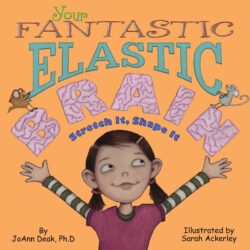SEL Read Aloud: Your Fantastic Elastic Brain by JoAnn Deak

Summary
“Your Fantastic Elastic Brain” by Joanne Deak explores the amazing capabilities of the human brain. Through engaging explanations and illustrations, it teaches young readers about different parts of the brain—such as the cerebrum for thinking, the cerebellum for movement, and the amygdala for emotions—and their unique functions. The book emphasizes the brain’s ability to grow and adapt through learning and making mistakes, a process known as neuroplasticity. It encourages children to embrace new challenges, highlighting that making mistakes is an essential part of learning and that bravery in the face of the unknown can stretch the “elastic” brain, making it stronger and more capable.
Comprehension Questions
Six questions aligned to Bloom’s taxonomy for teacher’s to evaluate students’ comprehension
- Remembering: What are the main parts of the brain mentioned in the book, and what is their primary function?
- Understanding: How does the book explain the concept of making mistakes in relation to brain growth?
- Applying: Given what you learned from the book, how might you approach a task that initially scares you?
- Analyzing: Compare and contrast the roles of the cerebrum and cerebellum as detailed in the book. How do their functions impact learning?
- Evaluating: Judge the effectiveness of using a character like the one described in the book to teach children about the brain. Is this an effective method to explain complex concepts?
- Creating: Create a plan to teach younger students about the importance of a growth mindset using information from the book.
CASEL Discussion Questions
Five questions aligned to the CASEL competencies for teachers to foster an engaging discussion and foster social-emotional learning
- Self-Awareness: Consider how your interests and hobbies have shaped your brain. How does this knowledge influence your view of yourself and your abilities?
- Self-Management: Create a plan for a new skill you want to learn. How will you apply the concept of neuroplasticity to manage your progress and setbacks?
- Social Awareness: How does recognizing that everyone’s brain can grow and learn help you understand and empathize with others’ learning processes and challenges?
- Relationship Skills: Discuss strategies for giving constructive feedback that encourages a growth mindset in others, based on the brain’s ability to change and adapt.
- Responsible Decision Making: How can knowledge of the brain’s elasticity influence your decisions when faced with peer pressure or challenging social situations?
Design Thinking Challenge
Take students’ learning even further by incorporating the Imagineerz design thinking framework
Create a Brain Growth Booster
Understand
- Start with a shared reading of “Your Fantastic Elastic Brain” by JoAnn Deak. Focus on discussing the amazing abilities of the brain to grow, learn, and adapt through experiences, mistakes, and new challenges. Open a discussion about how the brain changes with learning and the importance of stretching our brains by trying new things, even if they seem difficult at first. Ask students: How does your brain change when you learn something new? Why is it okay to make mistakes according to the book?
Ideate
- Encourage students to brainstorm ideas for a device that promotes brain growth and learning, inspired by the concept of the brain being “elastic.” They should think about what kind of device could encourage users to embrace challenges, learn from mistakes, and celebrate learning new things. What elements could the device include to remind users about the importance of persistence and the positive aspects of stretching their brain? Could it incorporate visual aids, motivational quotes, or brain challenges?
Prototype
- Students will use recycled materials like cardboard boxes, plastic containers, and old magazines to build a “Brain Growth Booster” prototype. Their device might include puzzles, mazes, memory games, or areas to jot down new things they’ve learned or want to learn. Encourage them to be inventive in how the device engages with users to promote learning and reflection on growth.
Test
- Have students present their prototypes, sharing how their device encourages brain growth, learning, and resilience in the face of challenges. They should explain the features of their device and how these features are intended to motivate and remind users of their brain’s elasticity and capacity for growth.
- Collect feedback focusing on how effectively the device encourages learning and growth mindset. Ask: How does the device inspire you to learn and grow? What improvements or additions could make it even more motivating and supportive of brain growth?
Read Aloud
Additional Resources
Copyright Notice
The image on this page comes from the book Your Fantastic Elastic Brain by JoAnn Deak. Copyright © 2010 by JoAnn Deak.


